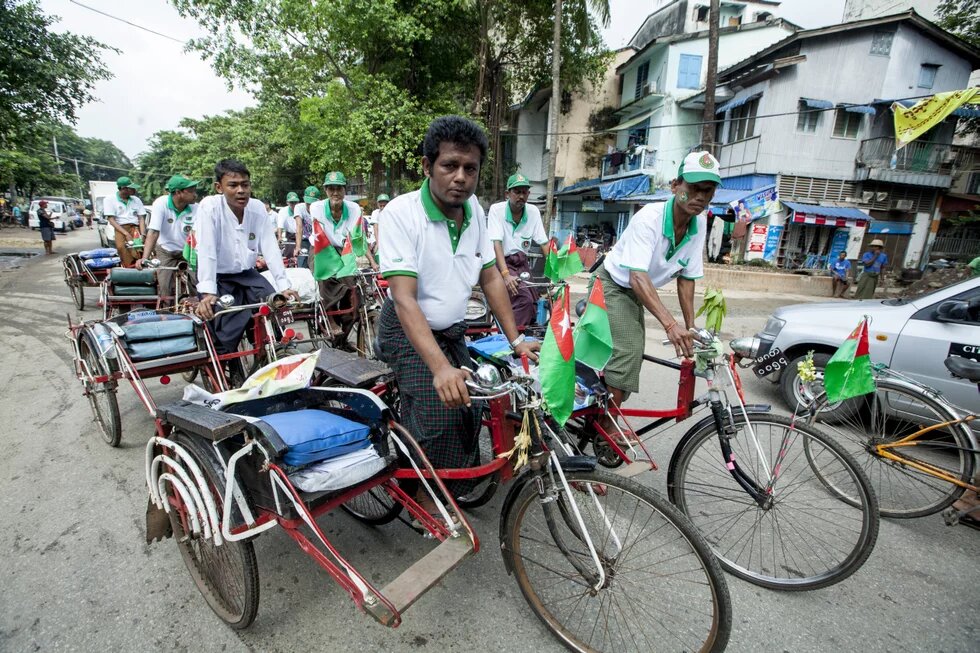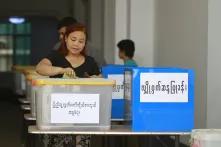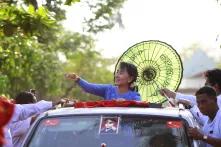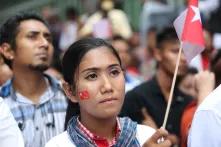
Introduction
Myanmar prepares for the second nation-wide poll in 25 years. Whereas the elections five years ago brought a semi-civilian government into power that initiated a major political liberalisation, the elections in November 2015 promise to be a watershed for the country’s democratisation. Although the military remains a veto actor par excellence and still plays a dominant role in the evolving semi-democratic order, the elections will have a deciding impact on the balance of power between reformist and conservative forces in the country and, thus, on the future of the country’s transition.
This paper discusses the state of Myanmar’s transition using insights from transformation research. It focusses on some of the key structural background conditions that build key “constraints to what is possible under such situations”1 and highlight the strategies of the main actors involved. Based on an analysis of the choices of the actors involved, the paper elaborates on the challenges of Myanmar’s transition. It concludes with an outlook for the prospects of democratisation in the years to come.
Myanmar: An unlikely democracy
The structural preconditions for a stable democracy to emerge are rather bleak. According to the different variants of modernisation theory, Myanmar lacks a series of conditions conducive to a stable democracy, such as a large and independent middle class, a low poverty rate, and high rates of economic growth. With a gross domestic poverty level of $915/year, the country is one of the poorest in Asia; 50 years of repressive military rule have left Myanmar decades behind most of its neighbours. Since Myanmar’s economy relies heavily on income derived from oil and gas, the country is at risk of falling prey to the “resource curse”.2
The most serious predicament in establishing democracy here is the lack of a functioning state and of a state identity that is supported by all ethnic groups. Since independence from Great Britain in 1948, the Burmese state has been challenged by communist and ethnic rebellions. Especially after U Nu attempted to make Buddhism the state religion in 1961, nearly all ethnic groups decided to take up arms to secede from the Union. The military under General Ne Win stepped in to secure the country from disintegration and fought persistent counter-insurgency campaigns against the ethnic groups, which controlled large parts of the country during the 1960s and 1970s.3 After the communist revolt broke down at the end of the 1980s and the military regime managed to divide the ethnic groups by signing ceasefires, the military was able to make significant territorial gains. Recently, the Burmese Army has been able to gain more extensive control over some areas in the northern state of Kachin and the state of Shan. However, some areas at the border to China and Thailand are still controlled by armed ethnic groups. Some of the biggest armed groups – the United Wa State Army (UWSA) and the Kachin Independence Army – still control considerable territory.
Although the civil war has cooled down, it continues to have an impact on state-building. First, ethnic groups continue to harbour a deep mistrust towards both the central government and the military. They reject the state in its current form and feel discriminated against in political and cultural terms. They demand far-reaching constitutional change, “genuine federalism”, or any form of guarantee to protect their autonomy. Second, ceasefires have given ethnic rebels some breathing space, which they have used to develop some regions economically – most often for illicit activities such as drugs smuggling or weapons trading. As a consequence, some rebel groups such as the UWSA might be more interested in keeping the status quo than achieving a sustainable peace.
Closely connected to the question of state-building is the historic legacy of the military’s involvement in political affairs. Since independence, the military (Tatmadaw) has been involved in politics. It sees its main role in preserving “national sovereignty” and the “non-disintegration of the Union”. Even today, the trust of the military leadership in civilian politicians is low, and, consequently, the former military junta has designed a political system in which the military continues to play a dominant role.4 Key ministries are reserved for men in uniform; the military also has a majority in the National and Security Council. Moreover, 25 per cent of the seats in the legislature are reserved for the military. Accordingly, the role envisioned by the armed forces is that of a “moderator” between competing social forces.5
Making sense of Myanmar’s transition
Rather than focussing on the background conditions, some scholars emphasised the voluntary choices of strategic actors. Schmitter and O’Donnell describe a transition as a strategic choice between the government and the opposition, with hardliners and softliners within the regime and the opposition agreeing on a pact, which redefines the rules of the political game. However, Myanmar’s liberalisation was not the result of a rift within the military. Instead, it was initiated by the top military generals from a position of strength. Having protected military prerogatives and secured the old guard’s exit from power, the second guard under President U Thein Sein felt secure enough to liberalise the political system. Apart from these internal factors, several external factors stand out, such as the reduction of the dependence on China or Myanmar’s backwardness compared to other Southeast Asian nations.
The liberalisation has been fragile, with hardliners pitted against softliners, and the peace process was of paramount importance.6Consequently, the scope of Myanmar’s liberalisation was the result of numerous debates between different stakeholders, such as the president, the military, conservative and reformist elements in Parliament, members of the opposition, civil society, and various alliances of ethnic groups.7 Although the military did not act cohesively in Parliament unless military interests were at stake, it has not taken a backseat role either. It actively participated “in the national leadership role of the state”, as laid down in the Constitution.
Truce with the NLD and the release of political prisoners
Myanmar’s liberalisation started with President U Thein Sein’s dialogue with the leader of the oppositional National League for Democracy (NLD), Daw Aung San Suu Kyi, a liberalisation of the press, the release of political prisoners, and legal changes that allowed her party to re-register. The NLD participated in the April 2012 by-elections, which the international community regarded as a significant credibility test of the government. Though the by-elections represent an important step, their political relevance has been limited, since only a small number of seats were open, and the outcome could not significantly alter the balance of power in Parliament, which was (and still is) dominated by the Union Solidarity and Development Party (USDP).
The truce with the opposition could not have been achieved without the release of political prisoners. According to figures provided by the Assistance Association for Political Prisoners Burma at the end of 2013, the government has released 1,002 political prisoners.8 Further amnesties in 2013 and 2014 led the Office of the President to declare that Myanmar has no political prisoners anymore. Admittedly, a number of former political prisoners could join parties, become active members of civil society, and engage vividly in the reform process. Human rights groups, however, point to the increasing number of arrests since the new Peaceful Assembly law came into force. They see the arrested protestors as political prisoners – certainly a grey area, since the latter have violated the restrictive Peaceful Assembly law or older laws. As of June 2015, there were 169 political prisoners incarcerated, with 446 activists currently awaiting trial for political actions.9
Press liberalisation
One of the most significant changes has been an increase in press freedom. In 2014, Reporters without Borders listed Myanmar as 145th of 179 countries; prior to that, the country was ranked 151st (2013), 169th (2012), and 174th (2011). Internet control and censorship were relaxed already in 2011. In August 2012, the government proclaimed an end to prepublication censorship and the dissolution of the Press Scrutiny and Registration Division. Parallel to this, however, bureaucrats within the Ministry of Information exhibited a constant resistance to this opening. The Ministry tried to regain certain powers and attempted to curb press freedom. In February 2013, the government unveiled a draft of the Printing and Publishing bill, which imposed new censorship guidelines. Since the draft bill was written in secrecy, media organisations were shocked and began to lobby for revisions. After a year of lobbying in both Houses, Parliament approved a much less restrictive bill, together with the new media law that was drafted with the input of members of the Press council.
There are also older laws in place that call for prison sentences for those who disseminate certain types of information that are perceived to pose a threat to national security, domestic tranquillity, or racial harmony; report about corruption or ethnic politics; or portray the government negatively.10 The government has used its powers to suspend press freedom whenever it has felt the press violated this responsibility. For instance, in July 2012 the magazines The Voice and Envoy were suspended for reporting on a possible cabinet change. In February 2014 the government arrested five journalists and banned the privately owned Unity Journal for “disclosing state secrets” – it had published a story on the construction of a chemical weapons factory in central Myanmar. The reporters were sentenced to seven years in jail based on the 1923 State Secrets Act. All this indicates that there is still a way to go to establish a free press.
Moreover, press liberalisation proved to be a double-edged sword for Myanmar’s transition. On the one hand, it enabled a freer discussion about political reforms. On the other hand, it unleashed a Buddhist-nationalist discourse and the agitation of an ultra-nationalist movement that preached intolerance and violence against the country’s Muslim community. Xenophobic, nationalistic anti-Muslim sentiments were spread in the internet and social media platforms.
Freedom of movement and association
In 2011 and 2012 the government began drafting laws on freedom of movement and association. The Peaceful Assembly law enacted in 2011 allowed for peaceful demonstrations only under very specific conditions: According to the law, organisers were required to ask the authorities for “permission” five days in advance. It also imposed a one-year imprisonment penalty for protests staged without permission. The law has broadened freedom of movement considerably, leading to an increase in the number of protests. However, several applications have been rejected, such as the NLD’s attempt to commemorate Martyrs’ Day in 2012 and the student union’s wish to honour the 50th anniversary of the student protests at Yangon University.
Though civil society’s space has grown and many protests have been tolerated, a number of activists have been charged for demonstrating without permission. In November 2012 the authorities violently cracked down on a protest by villagers against the expansion of the copper mine in Letpadaung. More than 70 protesters were injured, when the riot police stepped in to quell the protests. A number of civil society activists have been jailed. The episode illustrates two developments: First, civil society activists have far more room to mobilise, lobby Parliament and the government, and make their voices heard. Second, the authorities and certain influential people – with vested interests – continue to use the law to stifle public protest. Although the Peaceful Assembly law was amended in March 2014, it is still used by the authorities to restrict the free movement of people. Authorities have targeted activists, farmers, and those organising around issues including land ownership and land rights.
The peace process
Although the Thein Sein administration managed to draft individual ceasefires with more than a dozen ethnic armed groups, it proved difficult to sign a nation-wide ceasefire. The lack of trust is a major issue. On both sides, economic interests are involved and major grievances need to be recognised, such as the negative impact of (military) development projects on local communities, such as land confiscations, and the environmental and social impacts of economic projects; competition over control of natural resources; poverty and underdevelopment.
Moreover, in order to accommodate the key ethnic demands of a federal state, the central government has to offer a political solution in terms of constitutional change. This, however, has not happened yet. The peace process then and again has been overshadowed by fighting between the military and some ethnic armed groups.
Constitutional reforms and national dialogue: The search for a new compromise
Aung San Suu Kyi has attempted to forge a pact with the military over the last few years. She has wooed the military, repeatedly praised its role, and on Armed Forces Day 2013 she attended the military parade in the capital. However, the military has not responded positively to any of these gestures. Allegedly, she had come to a form of understanding with Lower House Speaker Shwe Mann, to whom she was allegedly close. His removal from the position as chair of the USDP in August 2015 – backed by security forces – calls into doubt the chances for a broader democratisation of the country.
The NLD also attempted to influence the official revision of the 2008 Constitution. Calls for constitutional changes began to gain momentum in March 2013, when members of the USDP submitted a proposal to form a committee to review the Constitution. Between August 2013 and October 2014, two parliamentary committees discussed areas for amendment and considered submissions by the public, political parties, and government officials.
In June and July 2015, two bills were submitted to parliament. The military bloc in Parliament, however, vetoed most of the proposed changes.11 First, it blocked the lowering of the 75 per cent threshold for constitutional change to 70 per cent (Sec. 436), which would have reduced the veto power of the military. Second, it prevented the direct election of regional chief ministers, although it granted new legislative and revenue-raising powers to sub-national governments. This decentralisation is far less than ethnic groups have hoped for and will remain contested in the years to come. Daw Aung San Suu Kyi commented on the outcome: “It is not a strange result. It’s nothing special to be surprised about…. The amendments proposed by the USDP are not enough [for democratic reform]. Now, [the military] don’t want to accept even those changes. We must assume they are not for reform.”12
In line with her reform strategy, Daw Suu Kyi has been calling for a meeting with President U Thein Sein, Lower House Speaker Shwe Mann, and Armed Forces Commander Min Aung Hlaing since July 2013 to find an informal agreement. All, however, have declined her offer, pointing to the ongoing formal revision of the Constitution. At the end of October 2014, President U Thein Sein invited the country’s main political figures to discuss the political transition. The meeting – whether described as “disappointing” (Aung San Suu Kyi) or “the start of a new political culture” (President Thein Sein) – has to be seen as a trust-building exercise and further step in a protracted transition that will unfold over the years to come.
Conclusion
Myanmar’s liberalisation has brought tremendous political change. It eased repression and increased participation in the institutions designed by the military regime the decade before. The military, however, is still defining the scope of the current transition and has vetoed any form of substantial constitutional change before the elections. Consequently, Myanmar’s transition will only usher in some form of hybrid regime. Since the liberalisation has not fully guaranteed full civil liberties and political rights, the evolving political order will be semi-democratic at best and characterised by heavy military involvement in political affairs. Press freedom is also restricted. Despite a draft national peace agreement, fighting is going on in some parts of the country, leading to a continuation of mistrust and the desire for structural political changes.
The elections will have a decisive impact on the balance of power between the opposition, the ethnic groups, and the military. A number of observers expect a victory for the NLD – although it is now clear that NLD-leader Aung San Suu Kyi is barred from becoming president. The removal of Thura Shwe Mann as chair of the USDP shortly before the elections reduces the chances of a pact between the ruling party and the opposition. Allegedly, he has supported reducing the military’s role. Consequently, the ongoing transition will be protracted. Due to the long-term repressive character of the outgoing authoritarian regime and the institutionalisation of military rule within the last decade, the protracted transition might take years, if not decades, to evolve, and opposition forces will face numerous challenges in fully liberalising the regime.13Future setbacks and periods of stalemate cannot be ruled out.
This article is part of our dossier: Elections in Myanmar.
Notes:
[1] Adam Przeworski, Some Problems in the Study of the Transition to Democracy, in: Transitions from Authoritarian Rule: Comparative Perspectives, ed. Guillermo O’Donnell, Philippe C. Schmitter, and Laurence Whitehead (Baltimore: John Hopkins University Press, 1986), 47–63.
[2] Sean Turnell, Burma’s Insatiable State, Asian Survey 48:6 (2008): 958–976.
[3] Martin Smith, Insurgency and the Politics of Ethnicity (London: Zed Books, 1991).
[4] Marco Bünte, (2014): Burma’s Transition to Quasi-Military Rule: From Rulers to Guardians?, Armed Forces and Society 40:4 (2014): 742–762.
[5] Renaud Egreteau, Patterns of Military Behavior in Myanmar’s New Legislature, Asia Pacific Bulletin 33 (2013): 1–4.
[6] Kyaw Yin Hlaing, Understanding Recent Political Changes in Burma, Contemporary Southeast Asia 34:2 (2012): 197–216.
[7] Thomas Kean, Myanmar’s Parliament: From Scorn to Significance, in: Debating Myanmar’s Democratization, ed. by Nick Cheesman, Nicholas Farrely, and Trevor Wilson (Singapore, 2014), 43–75.
[8] Association of Political Prisoners, 56 Political Prisoners Freed in 12th Presidential Release, press release of the Assistance Association of Political Prisoners, November 11, 2013, available at: http://www.aappb.org (accessed 5 January 2014).
[9] Association of Political Prisoners, Monthly Chronology of June 2015, available at: http://aappb.org/2015/07/monthly-chronology-of-june-2015 (accessed 9 July 2015).
[10] Reporters without Borders, Burmese Media Spring, in: Reporters without Borders 2012, 38, available at: http://en.rsf.org/IMGpdf/rsf_rapport_birmanie-gb-bd_2_.pdf (accessed 14 October 2013).
[11] GNLM, Pyidaungsu Hluttaw Votes Down 5 of 6 Changes to Constitution, Global New Light of Myanmar, 26 June 2015.
[12] Myanmar Times, NLD Leader Says Military Has Shown People Who to Vote For, 26 June 2015.
[13] Marco Bünte, Myanmar’s Protracted Transition: Arenas, Actors, Outcomes, in: Asian Survey (forthcoming).


